Lightning Strike Protection: Current Challenges and Future Possibilities
Abstract
:1. Introduction
1.1. The Problem of Lightning Strike Protection
1.2. Metallic Solutions for LSP
2. Carbon-Based LSP Solutions
2.1. Carbon Black and Carbon Nanotubes for Lightning Strike Protection
2.2. Graphene-Based Solutions for Lightning Strike Protection
2.2.1. Mechanical Mixing
2.2.2. Vacuum-Assisted Implementation Techniques
2.2.3. Alternative Film Production
2.2.4. Comparison between Graphene-Based Solutions and Copper Mesh
3. Enhancement of Graphene LSP Properties
3.1. Silver Doped Graphene Composites for LSP
3.2. Graphene/CNT Composites
3.3. MXenes for LSP
4. Conclusions and Outlooks
Author Contributions
Funding

Institutional Review Board Statement
Informed Consent Statement
Data Availability Statement
Acknowledgments
Conflicts of Interest
References
- Scelsi, L.; Bonner, M.S.; Hodzic, A.; Soutis, C.; Wilson, C.W.; Scaife, R.; Ridgway, K. Potential emissions savings of lightweight composite aircraft components evaluated through life cycle assessment. Express Polym. Lett. 2011, 5, 209–217. [Google Scholar] [CrossRef]
- Airinfra. The European Green Deal: What Does This Mean for the Aviation Industry? 2020. Available online: https://airinfra.eu/blog/the-european-green-deal-what-does-this-mean-for-the-aviation-industry/?msclkid=a6dab7eea8f511ec8686c5520e20817a (accessed on 14 February 2023).
- Pierce, R.S.; Falzon, B.G. Simulating Resin Infusion through Textile Reinforcement Materials for the Manufacture of Complex Composite Structures. Engineering 2017, 3, 596–607. [Google Scholar] [CrossRef] [Green Version]
- Xu, Y.; Zhu, J.; Wu, Z.; Cao, Y.; Zhao, Y.; Zhang, W. A review on the design of laminated composite structures: Constant and variable stiffness design and topology optimization. Adv. Compos. Hybrid Mater. 2018, 1, 460–477. [Google Scholar] [CrossRef]
- Larsson, A. The interaction between a lightning flash and an aircraft in flight. C. R. Phys. 2002, 3, 1423–1444. [Google Scholar] [CrossRef]
- US Department of Transportation Federal Aviation Administration. Certification of transport airplane structure. In FAA Advisory Circular; US Department of Transportation Federal Aviation Administration: Washington, DC, USA, 1999. [Google Scholar]
- Feraboli, P.; Miller, M. Damage resistance and tolerance of carbon/epoxy composite coupons subjected to simulated lightning strike. Compos. Part Appl. Sci. Manuf. 2009, 40, 954–967. [Google Scholar] [CrossRef]
- Wang, B.; Zhu, Y.; Ming, Y.; Yao, X.; Tian, X.; Ziegmann, G.; Duan, Y.; Sun, J. Understanding lightning strike induced damage mechanism of carbon fiber reinforced polymer composites: An experimental study. Mater. Des. 2020, 192, 108724. [Google Scholar] [CrossRef]
- Feraboli, P.; Kawakami, H. Damage of Carbon/Epoxy Composite Plates Subjected to Mechanical Impact and Simulated Lightning. J. Aircr. 2010, 47, 999–1012. [Google Scholar] [CrossRef]
- Dhanya, T.; Yerramalli, C.S. Lightning strike effect on carbon fiber reinforced composites—Effect of copper mesh protection. Mater. Today Commun. 2018, 16, 124–134. [Google Scholar] [CrossRef]
- Black, S. Lightning Strike Protection Strategies for Composite Aircraft. 2013. Available online: https://www.compositesworld.com/articles/lightning-strike-protection-strategies-for-composite-aircraft (accessed on 13 January 2023).
- Gagné, M.; Therriault, D. Lightning strike protection of composites. Prog. Aerosp. Sci. 2014, 64, 1–16. [Google Scholar] [CrossRef]
- Zhang, B.; Patlolla, V.R.; Chiao, D.; Kalla, D.K.; Misak, H.; Asmatulu, R. Galvanic corrosion of Al/Cu meshes with carbon fibers and graphene and ITO-based nanocomposite coatings as alternative approaches for lightning strikes. Int. J. Adv. Manuf. Technol. 2012, 67, 1317–1323. [Google Scholar] [CrossRef]
- Backe, S.; Balle, F. A novel short-time concept for fatigue life estimation of carbon (CFRP) and metal/carbon fiber reinforced polymer (MCFRP). Int. J. Fatigue 2018, 116, 317–322. [Google Scholar] [CrossRef]
- Kausar, A.; Rafique, I.; Muhammad, B. Review of Applications of Polymer/Carbon Nanotubes and Epoxy/CNT Composites. Polym.-Plast. Technol. Eng. 2016, 55, 1167–1191. [Google Scholar] [CrossRef]
- Fogel, M.; Parlevliet, P.; Geistbeck, M.; Olivier, P.; Dantras, É. Thermal, rheological and electrical analysis of MWCNTs/epoxy matrices. Compos. Sci. Technol. 2015, 110, 118–125. [Google Scholar] [CrossRef] [Green Version]
- Schilde, C.; Schlömann, M.; Overbeck, A.; Linke, S.; Kwade, A. Thermal, mechanical and electrical properties of highly loaded CNT-epoxy composites—A model for the electric conductivity. Compos. Sci. Technol. 2015, 117, 183–190. [Google Scholar] [CrossRef]
- Zhang, J.; Zhang, X.; Cheng, X.; Hei, Y.; Xing, L.; Li, Z. Lightning strike damage on the composite laminates with carbon nanotube films: Protection effect and damage mechanism. Compos. Part B Eng. 2019, 168, 342–352. [Google Scholar] [CrossRef]
- Lin, W.; Wang, Y.; Yousefpour, K.; Park, C.; Kumar, V. Evaluating the Lightning Strike Damage Tolerance for CFRP Composite Laminates Containing Conductive Nanofillers. Appl. Compos. Mater. 2022, 29, 1537–1554. [Google Scholar] [CrossRef]
- Novoselov, K.S.; Geim, A.K.; Morozov, S.V.; Jiang, D.; Zhang, Y.; Dubonos, S.V.; Grigorieva, I.V.; Firsov, A.A. Electric Field Effect in Atomically Thin Carbon Films. Science 2004, 306, 666–669. [Google Scholar] [CrossRef] [Green Version]
- Castro Neto, A.H.; Guinea, F.; Peres, N.M.R.; Novoselov, K.S.; Geim, A.K. The electronic properties of graphene. Rev. Mod. Phys. 2009, 81, 109–162. [Google Scholar] [CrossRef] [Green Version]
- Redondo, O.; Prolongo, S.; Campo, M.; Sbarufatti, C.; Giglio, M. Anti-icing and de-icing coatings based Joule’s heating of graphene nanoplatelets. Compos. Sci. Technol. 2018, 164, 65–73. [Google Scholar] [CrossRef]
- Liu, S.; Fang, Z.; Yan, H.; Wang, H. Superior flame retardancy of epoxy resin by the combined addition of graphene nanosheets and DOPO. RSC Adv. 2016, 6, 5288–5295. [Google Scholar] [CrossRef]
- Monetta, T.; Acquesta, A.; Bellucci, F. Graphene/Epoxy Coating as Multifunctional Material for Aircraft Structures. Aerospace 2015, 2, 423–434. [Google Scholar] [CrossRef] [Green Version]
- Ramezanzadeh, B.; Ghasemi, E.; Mahdavian, M.; Changizi, E.; Mohamadzadeh Moghadam, M. Covalently-grafted graphene oxide nanosheets to improve barrier and corrosion protection properties of polyurethane coatings. Carbon 2015, 93, 555–573. [Google Scholar] [CrossRef]
- Lim, S.; Park, H.; Yamamoto, G.; Lee, C.; Suk, J.W. Measurements of the Electrical Conductivity of Monolayer Graphene Flakes Using Conductive Atomic Force Microscopy. Nanomaterials 2021, 11, 575. [Google Scholar] [CrossRef]
- Balandin, A.A.; Ghosh, S.; Bao, W.; Calizo, I.; Teweldebrhan, D.; Miao, F.; Lau, C.N. Superior Thermal Conductivity of Single-Layer Graphene. Nano Lett. 2008, 8, 902–907. [Google Scholar] [CrossRef] [PubMed]
- Zhao, Z.; Ma, Y.; Yang, Z.; Yu, J.; Wang, J.; Tong, J.; Yi, X.; Moreira, P.; Sguazzo, C. Light weight non-metallic lightning strike protection film for CFRP. Mater. Today Commun. 2020, 25, 101502. [Google Scholar] [CrossRef]
- Li, Y.; Zhang, H.; Huang, Z.; Bilotti, E.; Peijs, T. Graphite Nanoplatelet Modified Epoxy Resin for Carbon Fibre Reinforced Plastics with Enhanced Properties. J. Nanomater. 2017, 2017, 1–10. [Google Scholar] [CrossRef] [Green Version]
- Prolongo, S.G.; Moriche, R.; Rosario, G.D.; Jiménez-Suárez, A.; Prolongo, M.G.; Ureña, A. Joule effect self-heating of epoxy composites reinforced with graphitic nanofillers. J. Polym. Res. 2016, 23, 1–7. [Google Scholar] [CrossRef]
- Raji, A.R.O.; Varadhachary, T.; Nan, K.; Wang, T.; Lin, J.; Ji, Y.; Genorio, B.; Zhu, Y.; Kittrell, C.; Tour, J.M. Composites of Graphene Nanoribbon Stacks and Epoxy for Joule Heating and Deicing of Surfaces. ACS Appl. Mater. Interfaces 2016, 8, 3551–3556. [Google Scholar] [CrossRef] [PubMed]
- Zhang, B.; Soltani, S.; Le, L.; Asmatulu, R. Fabrication and assessment of a thin flexible surface coating made of pristine graphene for lightning strike protection. Mater. Sci. Eng. B 2017, 216, 31–40. [Google Scholar] [CrossRef] [Green Version]
- Kumar, S.S.; Uddin, M.N.; Rahman, M.M.; Asmatulu, R. Introducing graphene thin films into carbon fiber composite structures for lightning strike protection. Polym. Compos. 2019, 40, E517–E525. [Google Scholar] [CrossRef]
- Wang, B.; Duan, Y.; Xin, Z.; Yao, X.; Abliz, D.; Ziegmann, G. Fabrication of an enriched graphene surface protection of carbon fiber/epoxy composites for lightning strike via a percolating-assisted resin film infusion method. Compos. Sci. Technol. 2018, 158, 51–60. [Google Scholar] [CrossRef]
- Vertuccio, L.; De Santis, F.; Pantani, R.; Lafdi, K.; Guadagno, L. Effective de-icing skin using graphene-based flexible heater. Compos. Part B Eng. 2019, 162, 600–610. [Google Scholar] [CrossRef]
- Lamichhane, P.; Dhakal, D.R.; Chaudhari, S.; Jayalath, I.N.; Nelson, T.; Park, C.; Yousefpour, K.; Blum, F.D.; Vaidyanathan, R. Polyaniline doped graphene thin film to enhance the electrical conductivity in carbon fiber-reinforced composites for lightning strike mitigation. J. Compos. Mater. 2021, 55, 4445–4455. [Google Scholar] [CrossRef]
- Guo, Y.; Xu, Y.; Wang, Q.; Dong, Q.; Yi, X.; Jia, Y. Enhanced lightning strike protection of carbon fiber composites using expanded foils with anisotropic electrical conductivity. Compos. Part A Appl. Sci. Manuf. 2019, 117, 211–218. [Google Scholar] [CrossRef]
- Aircraft Spruce. Lightning Strike Protection Strategies for Composite Aircraft Copper Light/Strike 3CU7-125A. 2023. Available online: https://www.aircraftspruce.com/catalog/cspages/microGrid.php (accessed on 14 January 2023).
- Graphenea Inc. Reduced Graphene Oxide Powder. 2023. Available online: https://www.graphenea.com/collections/graphene-oxide/products/reduced-graphene-oxide-1-gram?variant=37183289589918 (accessed on 14 January 2023).
- Young, R.J.; Kinloch, I.A.; Gong, L.; Novoselov, K.S. The mechanics of graphene nanocomposites: A review. Compos. Sci. Technol. 2012, 72, 1459–1476. [Google Scholar] [CrossRef]
- Morimune-Moriya, S.; Goto, T.; Nishino, T. Effect of aspect ratio of graphene oxide on properties of poly(vinyl alcohol) nanocomposites. Nanocomposites 2019, 5, 84–93. [Google Scholar] [CrossRef] [Green Version]
- Arao, Y.; Mizuno, Y.; Araki, K.; Kubouchi, M. Mass production of high-aspect-ratio few-layer-graphene by high-speed laminar flow. Carbon 2016, 102, 330–338. [Google Scholar] [CrossRef]
- Zhu, Y.; James, D.K.; Tour, J.M. New Routes to Graphene, Graphene Oxide and Their Related Applications. Adv. Mater. 2012, 24, 4924–4955. [Google Scholar] [CrossRef]
- Coleman, J.N. Liquid Exfoliation of Defect-Free Graphene. Acc. Chem. Res. 2013, 46, 14–22. [Google Scholar] [CrossRef] [PubMed]
- Paton, K.R.; Varrla, E.; Backes, C.; Smith, R.J.; Khan, U.; O’Neill, A.; Boland, C.; Lotya, M.; Istrate, O.M.; King, P.; et al. Scalable production of large quantities of defect-free few-layer graphene by shear exfoliation in liquids. Nat. Mater. 2014, 13, 624–630. [Google Scholar] [CrossRef]
- Pei, S.; Cheng, H.M. The reduction of graphene oxide. Carbon 2012, 50, 3210–3228. [Google Scholar] [CrossRef]
- Fernández-Merino, M.J.; Guardia, L.; Paredes, J.I.; Villar-Rodil, S.; Solís-Fernández, P.; Martínez-Alonso, A.; Tascón, J.M.D. Vitamin C Is an Ideal Substitute for Hydrazine in the Reduction of Graphene Oxide Suspensions. J. Phys. Chem. C 2010, 114, 6426–6432. [Google Scholar] [CrossRef]
- Ostermann, M.; Velicsanyi, P.; Bilotto, P.; Schodl, J.; Nadlinger, M.; Fafilek, G.; Lieberzeit, P.A.; Valtiner, M. Development and Up-Scaling of Electrochemical Production and Mild Thermal Reduction of Graphene Oxide. Materials 2022, 15, 4639. [Google Scholar] [CrossRef]
- Kim, S.; Choi, K.; Park, S. Solvothermal reduction of graphene oxide in dimethylformamide. Solid State Sci. 2016, 61, 40–43. [Google Scholar] [CrossRef]
- Li, N.; Yan, W.; Niu, Y.; Qu, S.; Zuo, P.; Bai, H.; Zhao, N. Photoinduced In Situ Spontaneous Formation of a Reduced Graphene Oxide-Enwrapped Cu–Cu2O Nanocomposite for Solar Hydrogen Evolution. ACS Appl. Mater. Interfaces 2021, 13, 9838–9845. [Google Scholar] [CrossRef] [PubMed]
- Xu, W.P.; Zhang, L.C.; Li, J.P.; Lu, Y.; Li, H.H.; Ma, Y.N.; Wang, W.D.; Yu, S.H. Facile synthesis of silver@graphene oxide nanocomposites and their enhanced antibacterial properties. J. Mater. Chem. 2011, 21, 4593–4597. [Google Scholar] [CrossRef]
- Ismail, N.A.; Shameli, K.; Sukri, S.N.A.M.; Hara, H.; Teow, S.Y.; Moeini, H. Sonochemical synthesis of a copper reduced graphene oxide nanocomposite using honey and evaluation of its antibacterial and cytotoxic activities. Front. Mol. Biosci. 2022, 9, 995853. [Google Scholar] [CrossRef]
- Celzard, A.; Marêché, J.; Payot, F.; Furdin, G. Electrical conductivity of carbonaceous powders. Carbon 2002, 40, 2801–2815. [Google Scholar] [CrossRef]
- Li, Y.; Zhang, H.; Wu, B.; Guo, Z. Improving the oxidation resistance and stability of Ag nanoparticles by coating with multilayered reduced graphene oxide. Appl. Surf. Sci. 2017, 425, 194–200. [Google Scholar] [CrossRef]
- Tang, Y.; Gou, J. Synergistic effect on electrical conductivity of few-layer graphene/multi-walled carbon nanotube paper. Mater. Lett. 2010, 64, 2513–2516. [Google Scholar] [CrossRef]
- VahidMohammadi, A.; Rosen, J.; Gogotsi, Y. The world of two-dimensional carbides and nitrides (MXenes). Science 2021, 372, eabf1581. [Google Scholar] [CrossRef] [PubMed]
- Shayesteh Zeraati, A.; Mirkhani, S.A.; Sun, P.; Naguib, M.; Braun, P.V.; Sundararaj, U. Improved synthesis of Ti3C2Tx MXenes resulting in exceptional electrical conductivity, high synthesis yield, and enhanced capacitance. Nanoscale 2021, 13, 3572–3580. [Google Scholar] [CrossRef] [PubMed]
- Lipatov, A.; Goad, A.; Loes, M.J.; Vorobeva, N.S.; Abourahma, J.; Gogotsi, Y.; Sinitskii, A. High electrical conductivity and breakdown current density of individual monolayer Ti3C2Tx MXene flakes. Matter 2021, 4, 1413–1427. [Google Scholar] [CrossRef]
- American Elements. Ti3C2 MXene Powder. 2023. Available online: https://www.americanelements.com/titanium-carbide-ti3c2-12363-89-2 (accessed on 16 January 2023).
- Yan, J.; Ren, C.E.; Maleski, K.; Hatter, C.B.; Anasori, B.; Urbankowski, P.; Sarycheva, A.; Gogotsi, Y. Flexible MXene/Graphene Films for Ultrafast Supercapacitors with Outstanding Volumetric Capacitance. Adv. Funct. Mater. 2017, 27, 1701264. [Google Scholar] [CrossRef]
- Zhao, M.Q.; Trainor, N.; Ren, C.E.; Torelli, M.; Anasori, B.; Gogotsi, Y. Scalable Manufacturing of Large and Flexible Sheets of MXene/Graphene Heterostructures. Adv. Mater. Technol. 2019, 4, 1800639. [Google Scholar] [CrossRef]
- Kumar, V.; Yeole, P.; Majed, A.; Park, C.; Li, K.; Naguib, M.; Ravindranath, P.K.; Jafta, C.; Spencer, R.; Compton, B.; et al. MXene Reinforced Thermosetting Composite for Lightning Strike Protection of Carbon Fiber Reinforced Polymer. Adv. Mater. Interfaces 2021, 8, 2100803. [Google Scholar] [CrossRef]
- Hou, T.; Zhao, Y.; Ding, L.; Yan, C.; Wu, G.; Du, B.; Liu, Z.; Wei, M. Layered ultra-lightweight MXene based composite films for current conduction. Compos. Part A Appl. Sci. Manuf. 2022, 161, 107114. [Google Scholar] [CrossRef]
- International Energy Agency. The 2020 EU Critical Raw Materials List. 2020. Available online: https://www.iea.org/policies/15274-the-2020-eu-critical-raw-materials-list (accessed on 20 January 2023).
- Anasori, B.; Lukatskaya, M.R.; Gogotsi, Y. 2D metal carbides and nitrides (MXenes) for energy storage. Nat. Rev. Mater. 2017, 2, 16098. [Google Scholar] [CrossRef]
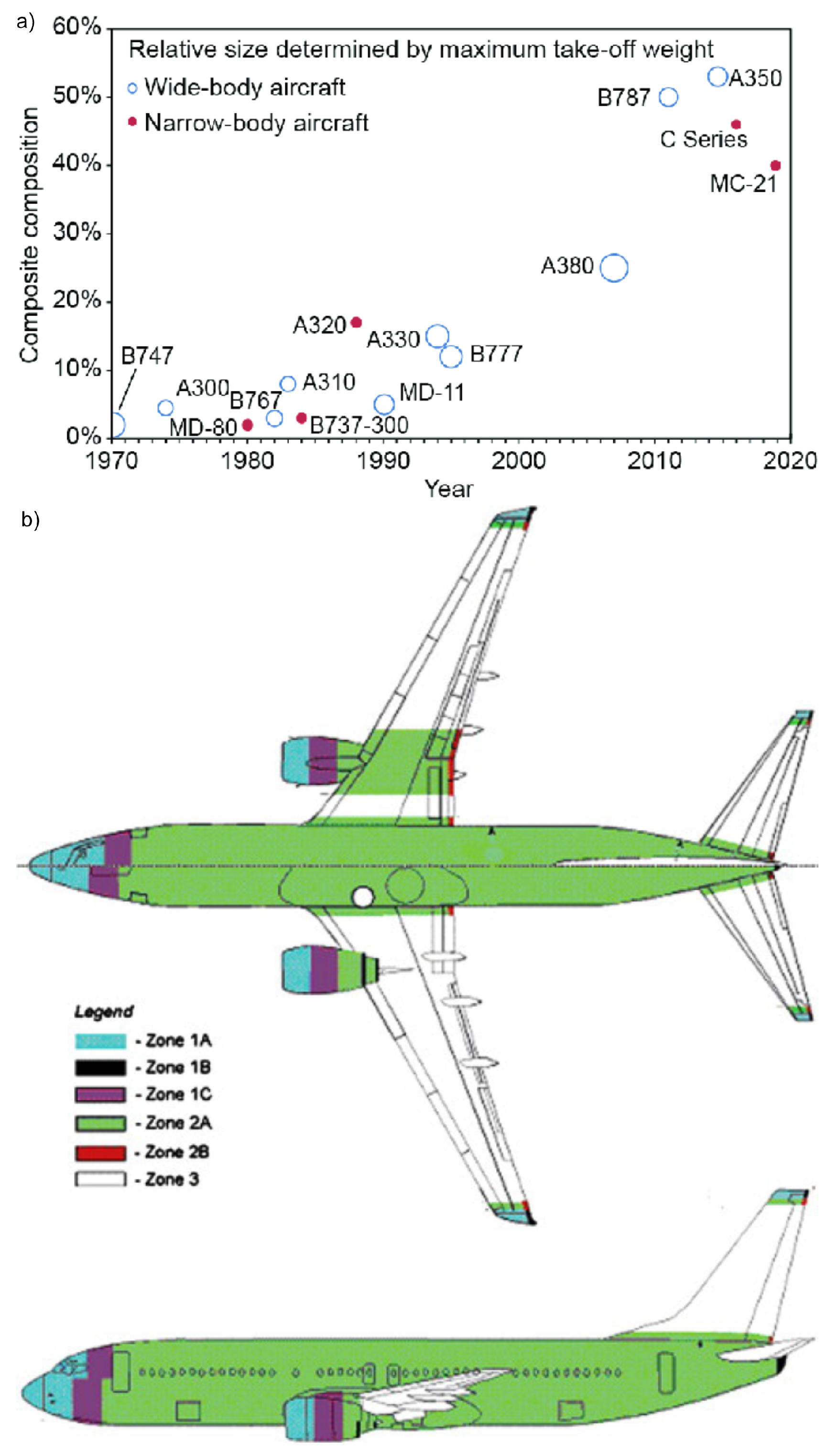
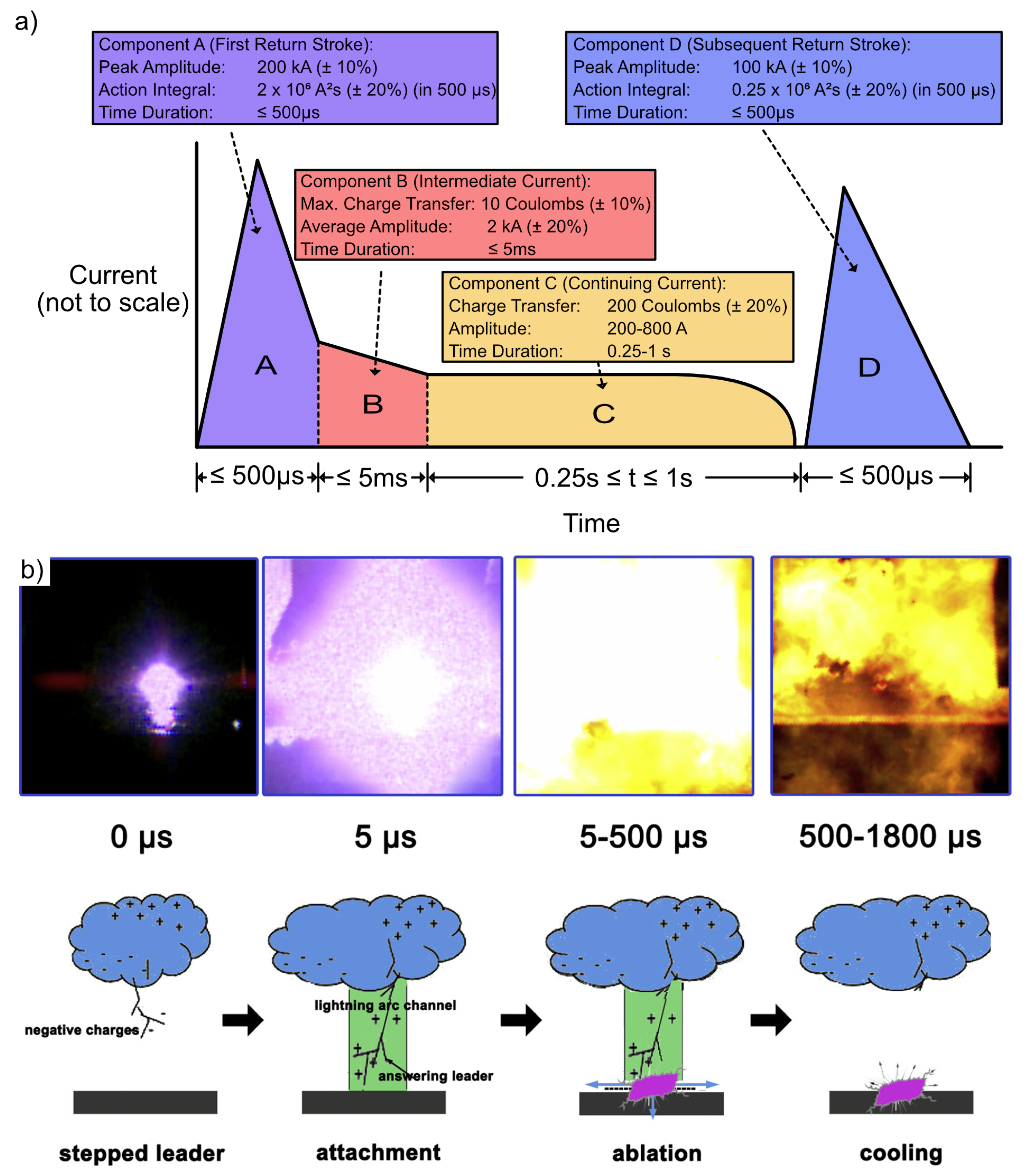
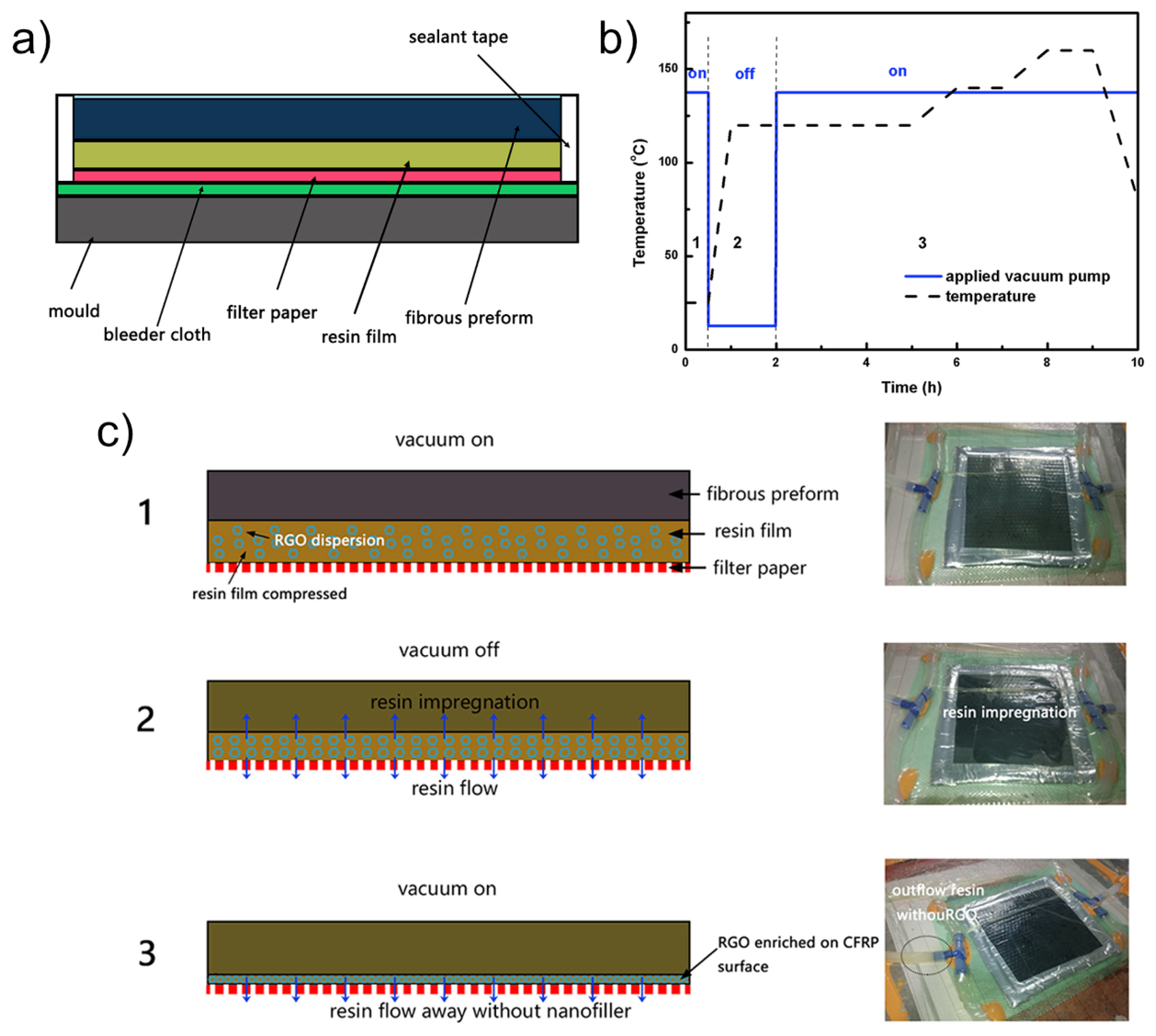
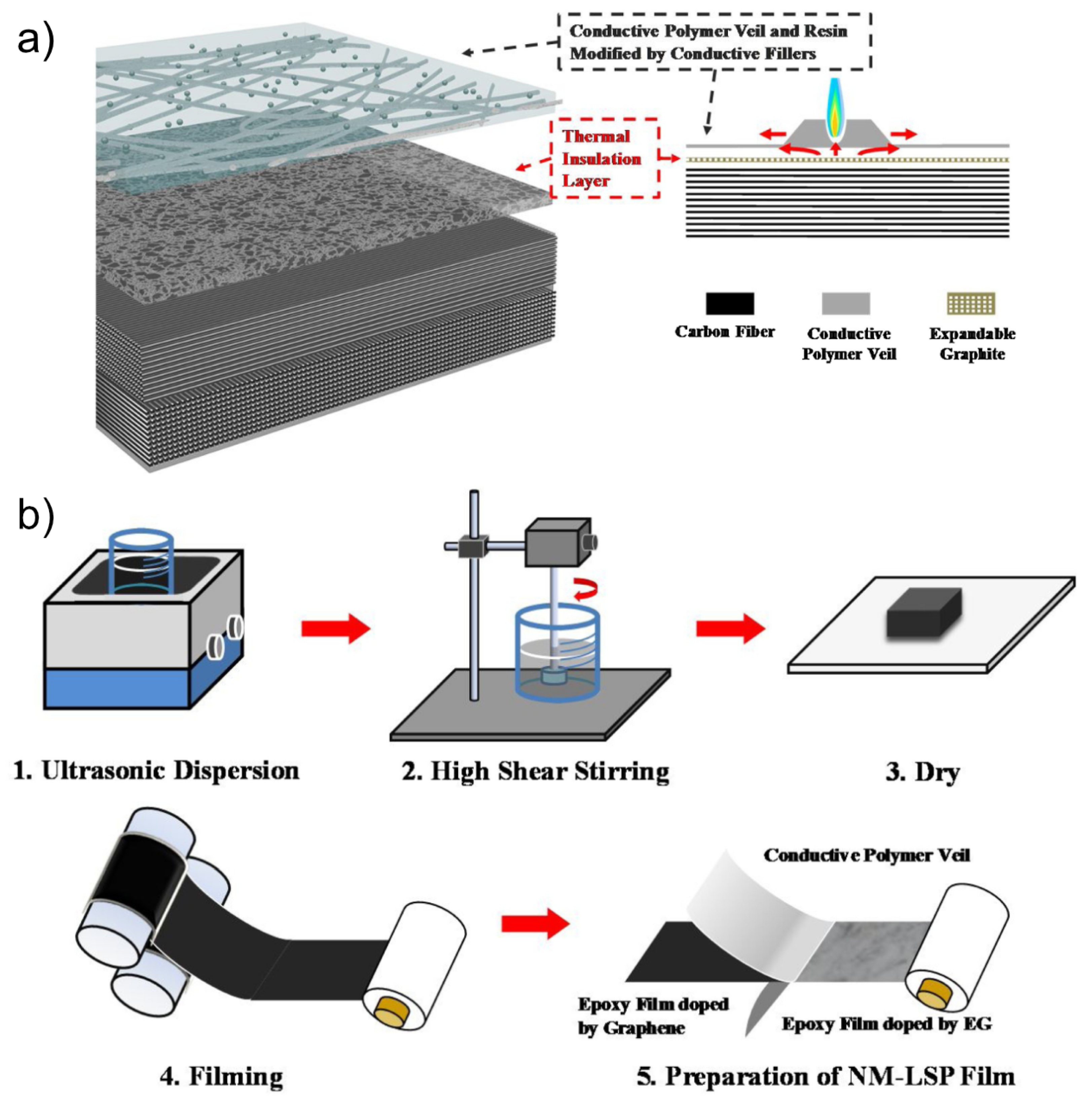
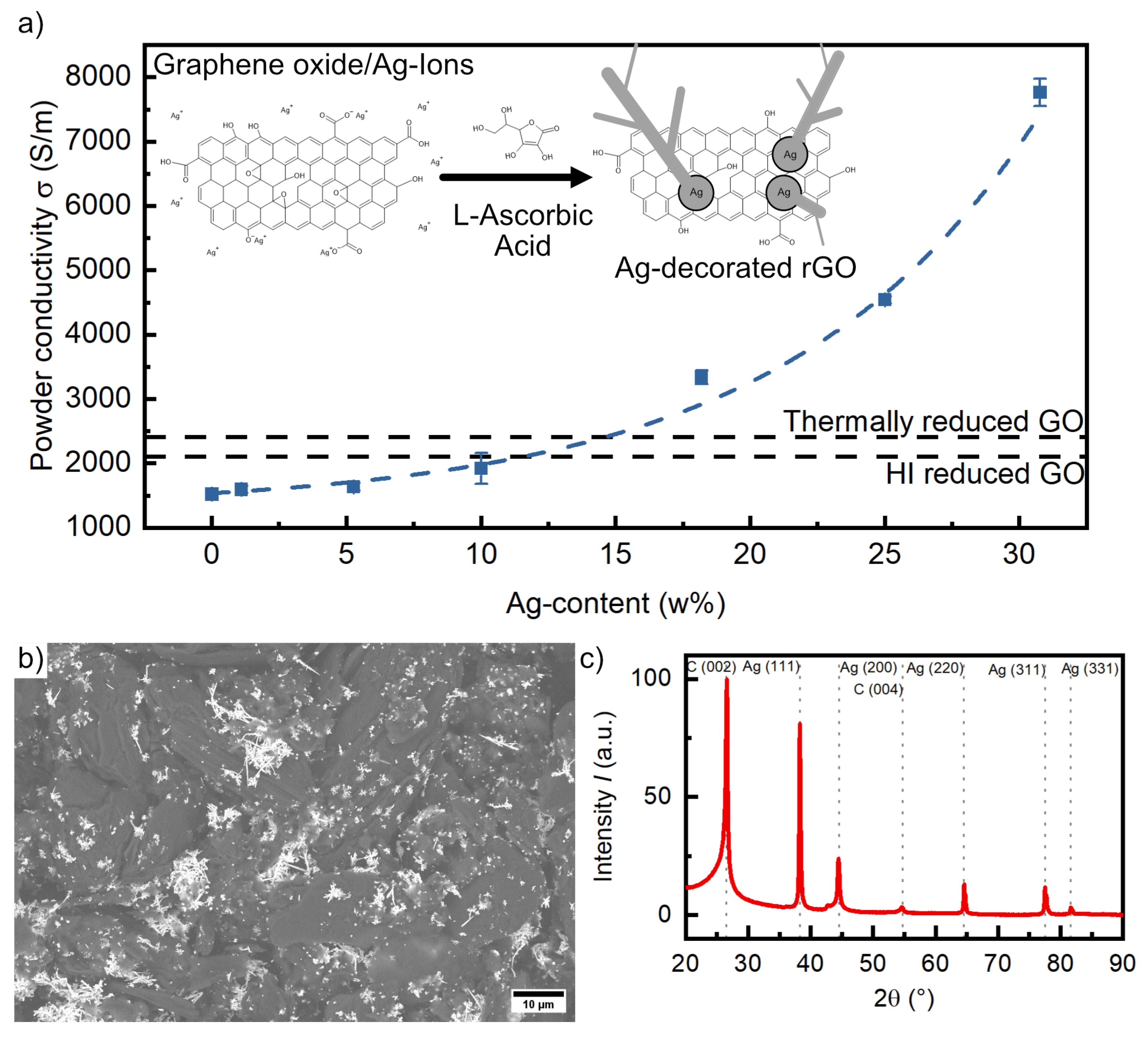
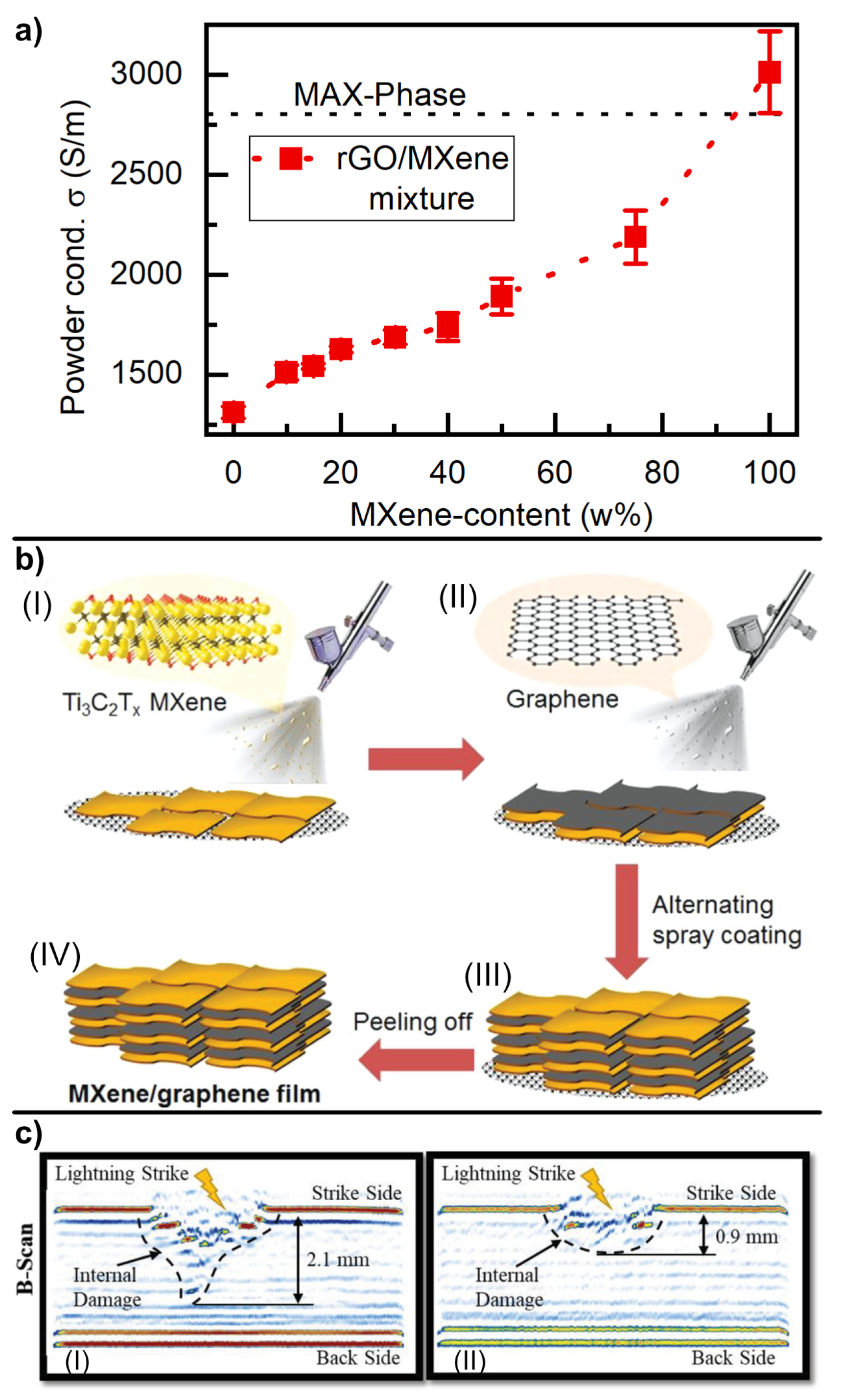
| Production Mechanism | Conductivity [S/m] | Reference | |
|---|---|---|---|
| Reference | Copper mesh for LSP | 2.2 × –1.2 × (depending on the direction) | Guo et al. [37] |
| 1 | Mechanical mixing into epoxy matrix | >1.0 × | Raji et al. [31] |
| 2 | Mechanical mixing into epoxy matrix | 4 × | Prolongo et al. [30] |
| 3 | Mechanical mixing into epoxy matrix | 3.8 × –8.4 × | Redondo et al. [22] |
| 4 | Mechanical mixing into epoxy matrix | 6.0 × | Li et al. [29] |
| 5 | Vacuum-filtration assisted film production of graphene film | 1.3 × –1.8 × | Zhang et al. [32] |
| 6 | Vacuum-filtration assisted film production of graphene film | 1 × –1.8 × | Kumar et al. [33] |
| 7 | Resin film infusion (RFI) | 3.7 × | Wang et al. [34] |
| 8 | Dispersion and evaporation casting of a graphene/PVA film | 6.6 × | Vertuccio et al. [35] |
| 9 | Production of graphene/PANI/PVP film | 2.5 × | Lamichhane et al. [36] |
| 10 | Comb. of graphene-enhanced matrix and metallised polymer veil | 2.7 × (Matrix); 1.4 × (Fiber) | Zhao et al. [28] |
| 11 | Spray-coating of rGO particles on glass-fibre composite | 5.0 × –3.3 × | This work |
Disclaimer/Publisher’s Note: The statements, opinions and data contained in all publications are solely those of the individual author(s) and contributor(s) and not of MDPI and/or the editor(s). MDPI and/or the editor(s) disclaim responsibility for any injury to people or property resulting from any ideas, methods, instructions or products referred to in the content. |
© 2023 by the authors. Licensee MDPI, Basel, Switzerland. This article is an open access article distributed under the terms and conditions of the Creative Commons Attribution (CC BY) license (https://creativecommons.org/licenses/by/4.0/).
Share and Cite
Ostermann, M.; Schodl, J.; Lieberzeit, P.A.; Bilotto, P.; Valtiner, M. Lightning Strike Protection: Current Challenges and Future Possibilities. Materials 2023, 16, 1743. https://doi.org/10.3390/ma16041743
Ostermann M, Schodl J, Lieberzeit PA, Bilotto P, Valtiner M. Lightning Strike Protection: Current Challenges and Future Possibilities. Materials. 2023; 16(4):1743. https://doi.org/10.3390/ma16041743
Chicago/Turabian StyleOstermann, Markus, Juergen Schodl, Peter A. Lieberzeit, Pierluigi Bilotto, and Markus Valtiner. 2023. "Lightning Strike Protection: Current Challenges and Future Possibilities" Materials 16, no. 4: 1743. https://doi.org/10.3390/ma16041743
APA StyleOstermann, M., Schodl, J., Lieberzeit, P. A., Bilotto, P., & Valtiner, M. (2023). Lightning Strike Protection: Current Challenges and Future Possibilities. Materials, 16(4), 1743. https://doi.org/10.3390/ma16041743







